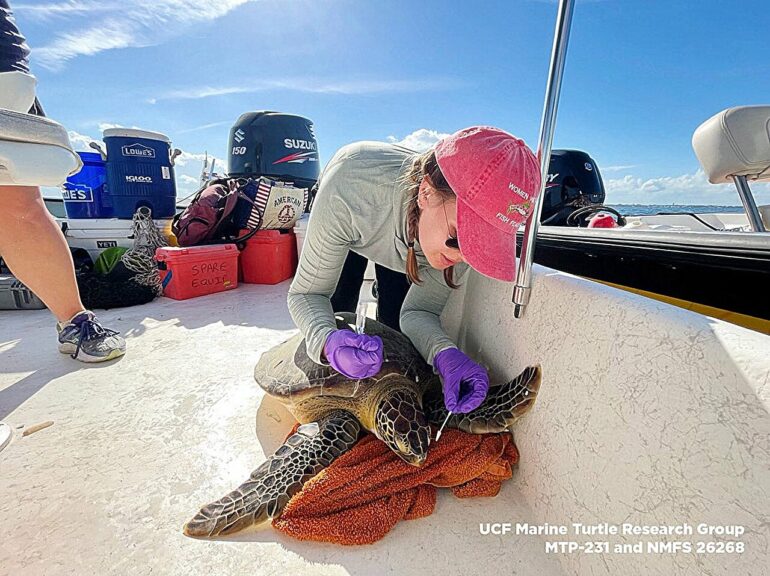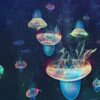The remarkable ability of migratory animals to navigate and recall routes may be attributed to a sensitivity to not just Earth’s magnetic fields, but perhaps an interaction with magnetic bacteria living inside them.
The relationship between these magnetic bacteria and the animals they reside in is not yet fully understood, but UCF Department of Biology Assistant Professor Robert Fitak recently compiled a database of animal DNA that houses hundreds of millions of sequences showing the presence of various types of magnetic bacteria to use as a tool in his pursuit to learn more.
The database signals a step forward in his research and builds off previous hypotheses and analyses published in 2020 in collaboration with colleagues in the United Kingdom and Israel.
In 2021, Fitak continued poring through databases to categorize which animals may host magnetic bacteria and if there are prevalent patterns.
“The first study we did was look at existing datasets and summarize where we found this bacteria in different animals,” he says.
“We searched about 50,000 previous scientific studies. Now, we actually expanded that to studying a worldwide database of genetic information and we’ve been able to summarize where these bacteria are located based on trillions of genetic sequences.”
The database was published earlier this year in Data in Brief, and it borrows information from the publicly available Sequence Read Archive from the National Center for Biotechnology Information.
Fitak focused on organizing DNA sequences originating from across animal species that match known magnetic bacteria to assist he and other researchers to narrow their efforts in examination of both environmental and ecological roles of magnetic bacteria or to identify potential host animals.
An internal compass?
Fitak and his colleagues are using the refined data to identify potential host organisms for the magnetic bacteria and to provide greater context for examining the roles they may play in animals—such as for navigation.
“Ultimately, if we have a better understanding of how animals navigate, it’ll be useful for conserving endangered or protected species,” Fitak says. “If we know where they’re going to move and how, it can help us make more accurate management decisions.”
He is interested in seeing if the magnetic bacteria reside in regions within an animal so they may sense them, such as parts of the nervous system. Fitak thinks they could serve as a navigational aid for animals or provide an additional boost for creatures like birds or sea turtles already using the Earth’s magnetic field to navigate long distances.
“It’s almost like a microbial compass and we’re studying how that could work,” Fitak says. “We think the animals already use the Earth’s magnetic field like a compass.”
He also says another potential benefit is that scientists may study how animals sense the magnetic fields and potentially mimic how they’re used in a variety of applications such as drug delivery.
However, there is no conclusive evidence that these animals are using the magnetic bacteria to navigate or not, Fitak says.
“The big summary we have so far from our research is that we don’t yet know that these bacteria are sensing the bacteria for the animal, but we do have evidence that they are living in these animals,” he says.
“But what we’ve learned is we can use genetic tags that are signatures for bacteria that makes magnets, and we’ve identified these genetic signatures of these bacteria inside various animals—including humans.”
These kinds of bacteria often live in sediments or muds where there isn’t a lot of oxygen, Fitak says. They assemble microscopic and magnetized iron “chains” to assist in their movement, he says.
It is uncertain how organisms end up with these bacteria inside of them, but it is theorized perhaps through absorption or consumption, Fitak says.
“To date, our results across projects show that these magnetic bacteria seem to be a regular component of many species microbiomes,” he says. “Hopefully our future work will show whether they are just incidentally gathered from the environment, a functional component of magnetic sensing for a host animal, or for some other unknown reason.”
Focusing on sea turtles
Fitak and his team of student researchers are focused on examining samples from green and loggerhead sea turtles to further study magnetic bacteria.
“Sea turtles are kind of a model of animal navigation,” he says. “We’ve been testing our hypotheses in sea turtles since they travel to very specific places very accurately.”
Focusing on sea turtles was a natural next step since they are known to possess magnetic bacteria and they rely on the Earth’s magnetic field to migrate, Fitak says. UCF’s Marine Turtle Research Group has also been instrumental in obtaining samples of turtles, he says.
Julianna Martin, a Ph.D. student working with Fitak, has helped analyze and collect the nearly 150 sea turtle samples.
“I work in the lab to extract the DNA from the samples and use genomics to identify what bacteria are in the samples and which are the magnet making ones we’re looking for,” she says. “I couldn’t collect the samples without the help of the UCF Marine Turtle Research Group. It’s been a team effort.”
Martin and scientists with UCF’s Marine Turtle Research Group gently collect tear samples with soft swabs from nesting females—who enter an almost trance-like state when laying eggs—and juveniles in the Indian River lagoon.
The turtles produce large goopy tears when they are on land to keep their eyes moist, and collecting them takes around 30 seconds, Martin says.
“We started with the tear ducts because they’re associated with nerves that are associated potentially with animals’ magnetic sense,” she says. “It makes sense biologically to look there and it’s easy to collect sea turtle tears.”
Martin says she is pleased with their progress thus far but is hoping their momentum propels their research toward more definitive conclusions.
“This research has been really exciting,” she says. “No one had been looking for them specifically in sea turtles. I’m interested in knowing where they came from and what species of magnet-making bacteria each sea turtle species has. It’s a long way away but for now we’re working on describing, ‘are they there?’ and ‘where do they come from?'”
The potential to share the unique discovery of magnetic bacteria aiding animals in navigation is truly wondrous, Fitak says.
“What’s been exciting is just being able to tell people that there are bacteria that exist in this world that make magnets,” he says. “People are awestruck, and it would be incredible if animals were indeed using these magnetic bacteria to navigate.”
Fitak encourages researchers interested in studying magnetic bacteria to explore the data he compiled.
More information:
Robert R. Fitak, The magneto-microbiome: A dataset of the metagenomic distribution of magnetotactic bacteria, Data in Brief (2024). DOI: 10.1016/j.dib.2024.110073
Provided by
University of Central Florida
Citation:
New database reveals presence of magnetic bacteria in animals (2024, July 9)



